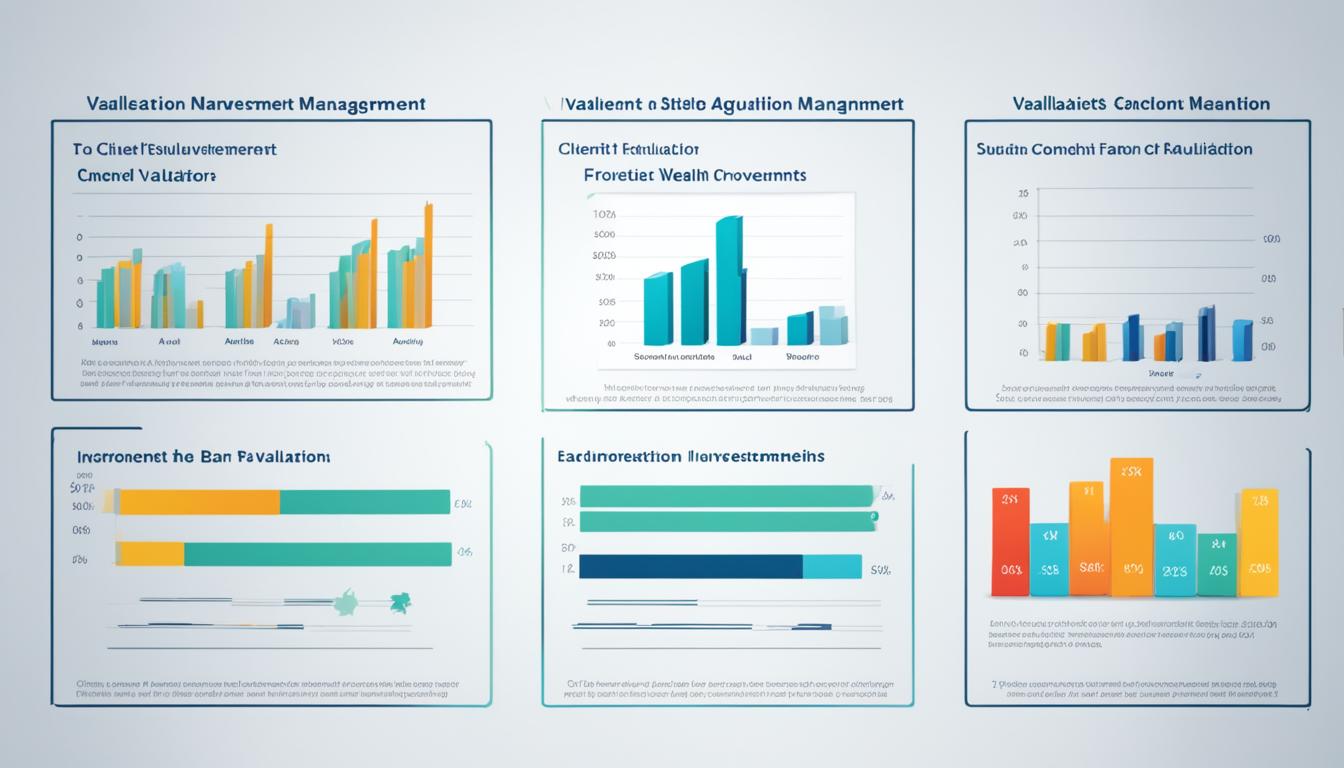Valuing a wealth management firm is not easy, it involves many important things. You have to look at the specific situation and the industry. Every part of this affects how much the firm is worth.
In the past, some simple rules have been used, but now experts say we need to look deeper. This article will help guide you through valuing a wealth management firm. It will share important things to think about and the methods to use.
Key Takeaways:
- Valuing a wealth management firm requires a comprehensive approach that considers multiple factors.
- It is important to analyze the specific context of the valuation and the state of the wealth management industry.
- Traditional rules of thumb may not be sufficient, and professional valuation practitioners recommend a more comprehensive approach.
- This guide will cover key considerations and valuation methods for valuing a wealth management firm for investment and acquisition.
- By understanding the complexities of valuation, investors and acquirers can make informed decisions.
Understanding the Context of Wealth Management Valuation
Valuing a wealth management firm is a complex task. It considers many factors. This includes the reason for the valuation and the state of the industry. Thinking about these elements helps us see how valuable the firm may be.
Experts in valuation say we can’t rely just on simple rules. For example, valuing firms only by a percentage of AUM is not enough. They suggest looking at different methods and techniques. This gives a more exact idea of a firm’s value.

When valuing a wealth management firm, we look at its financial standing and potential growth. We also consider who their clients are and what services they offer. Even their brand’s power and how well they follow rules matter. These details are all important in finding out the firm’s true worth.
“Valuing a wealth management firm requires a comprehensive analysis that considers the specific context and key factors affecting its value.”
Valuing a wealth management firm goes beyond just numbers. Things like how loyal their clients are and the quality of their team influence worth too. Understanding a firm deeply helps investors and buyers make smart choices. They can then see how valuable the firm truly is.
The Evolution of the Wealth Management Industry
The wealth management industry has changed a lot over the years. This change came from new rules and market needs. It started after World War II. At first, it was mostly about trading securities for banks. Now, it’s all about helping people invest wisely for their future.

In the 1980s, everything changed. A new kind of wealth advisor appeared, called a registered investment advisors (RIAs). They focused more on planning for the future. This was a big shift from just making money from selling financial products. The rise of RIAs showed a move towards truly helping clients.
Since then, the wealth management world has boomed. More RIAs started and more professionals joined their ranks. The amount of money they handle also grew a lot. Now, RIAs are a key part of the wealth management scene.
This growth means big things for the wealth management business. It changes how we think about the worth of these firms. It’s important to keep up with the changes in this field. Understanding these changes helps us see the true value of wealth management companies.
Key Factors in Valuing a Wealth Management Firm
Valuing a wealth management firm looks into several key elements. These include its clients and relationships, financial stats, and growth potential. Also important are the services it offers, its brand, and compliance with rules.
Knowing the clients and how well the firm relates to them is key. It gives clues about earning money in the future and keeping clients happy.
Numbers like revenue growth help to see how well the firm is doing financially. These figures are compared with what’s normal in the industry.
The ability of the firm to grow and make more money is also critical. A firm that can grow a lot is seen as more valuable.
The kinds of services a firm has and how they meet clients’ needs matter. This shows how competitive the firm is within its market.
Having a good name and a big market share also makes a firm more valuable. A strong brand helps attract and keep clients.
Having the right tools and systems in place is key for a firm’s success. This includes how efficiently they work.
Sticking to rules and regulations is very important in this business. It keeps the firm out of legal trouble and lowers risks.
Looking at the overall industry and trends is crucial too. It helps to see where the firm stands and what the future might hold.
Each of these areas is critical in how we figure out a wealth management firm’s value.

Integration and Client Retention in Wealth Management Acquisitions
Acquiring a wealth management firm involves bringing it into the buyer’s business. Doing this well is key to the deal’s success. It includes keeping important workers, handling how clients move over, and looking at contracts with outside parties. Keeping clients happy after buying the firm is vital. This part talks about how to blend the two firms and keep the clients happy.
Integrating the bought firm is crucial to gain benefits and make operations smoother. Keeping the key workers means keeping client services strong. The buyer should look at the talent in the new firm, find the crucial staff, and come up with ways to keep them.
Handling how clients switch over is also key. Making sure they are happy and stay is important. Open ways to talk with them should be set up to deal with their worries. Keeping the quality of service steady will help keep their trust and stop them from leaving.
Looking at outside contracts is a big part of merging. The buyer needs to check the deals the firm already had with others like technology firms or suppliers. This helps to find and solve any issues, making the switch go smoothly.
Keeping the clients after buyout is very important. The buyer should focus on making the clients happy. They might do this by talking directly with them, offering better services, or adding new benefits. This keeps the clients happy and loyal.

Conclusion
Valuing a wealth management firm needs a detailed approach. It looks at many factors. With comprehensive analysis, like client details, finances, growth, and how things work, smart decisions are made. This is more than just using simple rules to value a company.
The step after valuation is key too. Integrating the firm you bought and keeping clients are vital. Making the new firm work well with your existing one is essential. It helps keep top people and clients, making for a smooth change and keeping the new firm’s value high.
We’ve covered a lot in this guide. We talked about how to value a wealth management firm, how the industry has changed, and what to look at when buying one. We also looked at why integrating and keeping clients are so important. This info helps people and companies understand the wealth management world better.
FAQ
How do I value a wealth management firm for investment or acquisition?
To value a wealth management firm, you need to look at many things. These include the reason for the valuation, the firm’s aspects, and the industry’s current situation. You have to check things like who their clients are, how well their money grows, if they can grow more, what they offer, and how strong their brand is. Also, you look at how well they follow the rules and the general market conditions.
What is the importance of understanding the context when valuing a wealth management firm?
It’s important to know the context because this gives you an idea of the investment’s returns. The purpose of the valuation, the firm itself, and the industry’s state all guide the firm’s value. This helps you make a smarter choice when investing.
How has the wealth management industry evolved over the years?
The wealth management industry has changed a lot due to rules and the market. It started after World War II. In the 1980s, it grew with more focus on fee-based and planning services by RIAs. The number of these advisors, experts, and the money they handle has grown a lot since then.
What are the key factors in valuing a wealth management firm?
When valuing a wealth management firm, look at their clients and how they manage money. Check how much they can grow and what they offer. Think about their brand and how well known they are. Also, see if their systems and operations follow the rules. Pay attention to the overall market too. Each of these areas plays a part in figuring out the firm’s value.
How important is the integration and client retention process in wealth management acquisitions?
Good integration and keeping clients are key to a wealth management acquisition’s success. It’s important to keep key staff and help clients move smoothly. You also need to look at contracts with outside parties. Keeping the newly acquired firm’s client base is essential to maintaining its value.